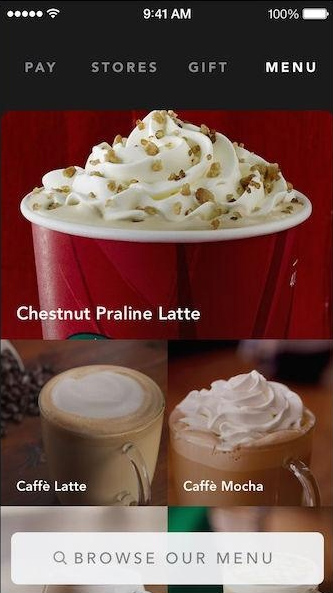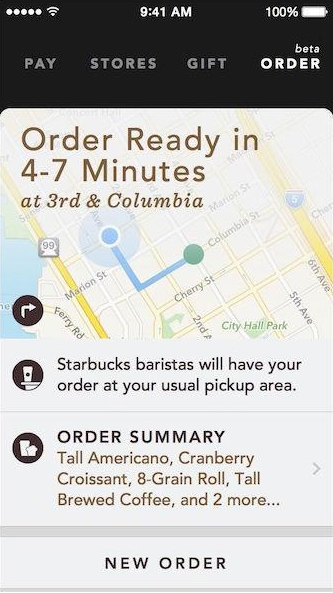What if I told you there was a magical place where you could try out several cutting-edge services coming in the near future? No, it’s not Best Buy, or a rich friend’s house: it’s Starbucks. Forget how you feel about its coffee, or if it’s as cool as your local cafe; Starbucks is rapidly becoming the best place for tech fans to try out a host of technologies they’ve only read about on the Internet.
Starbucks mobile ordering system is the newest such tech. In recent months, it has left its trial stage, spread through new cities in the United States, and made its debut in London. On its own, this new ordering system is very cool already, but taken as part of Starbucks continued trend of embracing genuinely useful consumer technology, it’s considerably more exciting.
Mobile app supports mobile payments, and Apple Pay
The mobile ordering system is simple to use. Provided you’re running the latest version of the Starbucks app, an Order button can be found in the top right of the screen, which opens up the option to order a coffee before you even get to the store. The idea is to beat the queues, or simply not have to wait when you arrive. The app automatically tracks your location, and recommends the closest participating branch, along with an approximate ETA for your White Mocha Frappuccino.
I didn’t want the Starbucks that the app suggested, but a tap opens up a map with alternative choices. Being in London, I chose the excellent Great Portland Street branch, which it said was a 10-minute walk away. On with the order. The majority of Starbucks products are available, including most hot drinks, ice coffees, and a selection of food. The cart works just like any other, and you add your choices before being prompted to pay.
Starbucks has the tech we’ll all us a lot more in the coming years.
This is done through a stored Starbucks loyalty card, or by Apple Pay (coming soon to stores in the U.S.), with which I topped up the card inside the app. The payment took 30-seconds to go through, and the 10 minute walk — guided by Apple Maps — was accurate. When I arrived, I was asked my name after saying I’d ordered ahead and sure enough, there was my coffee, all ready and waiting. My bagel, however, was not. They’d just sold the last one a few moments before I ordered.
Disaster? No. I was told to choose whatever else I liked, and as an apology was given a token for a free drink next time I visited. It’s very difficult to be critical when you get that kind of apologetic response to an already well-handled situation. What I’ve just described wasn’t at a trade show, or some limited release at a shop you’ll never visit, it’s Starbucks. What’s more, it’s the tech we’ll all use a lot more in the years to come.
More convenience than time saving
Did I save much time? It’s hard to say, as for once, there was no line when I arrived. I asked if I’d still have had to queue up even though I’d ordered ahead, and the answer was yes, so any dreams of running in, grabbing a coffee and then shooting off again may be over exaggerated. However, once you reach the head of the queue, there’s no waiting, so the convenience factor is high.
Checking the app again reveals my order was saved, so it’s easy to repeat your order daily if you’re a creature of habit. That’ll minimise the time it takes to place the order, which on this first occasion arguably took the same amount of time had I actually been in the shop. It’s also worth noting that my initially ordered bagel was now listed as out of stock at my chosen branch, so the app is kept up to date at a local level.
If you’re a tech fanatic, ordering and paying with a smartphone may not feel that space-age, but millions of regular folks will probably learn about, and try it, at a Starbucks. There’s nothing more depressing than being presented with cool new tech that only does half of what’s promised, but Starbucks delivers with its mobile ordering. It worked faultlessly, and that’s important if normal, non-geeks are going to use it.
A trifecta of cool tech
It’s the same story with that other Starbucks tech innovation, which I used after I sat down with my coffee: Wireless charging. It’s built into the tables, just like in McDonalds, but unlike the fast-food restaurant, Starbucks provides little plug-in dongles so it can be used by everyone no matter what phone they put down. Regular people don’t care about the industry fight over wireless charging standards; they just want it to work because it’s way more convenient than carrying a charger around. Like the app, wireless charging just works in Starbucks.
The trifecta of free Wi-Fi, mobile ordering using a solid app, and in-store wireless charging may not be unique, but Starbucks commitment to having it all work in a seamless way, that’s easily understood by everyone, is definitely unusual. I’m known for being a Starbucks-aholic, but when this much accessible, usable tech is inside (along with a lovely, refreshing Mocha Frappuccino), it shouldn’t come as much of a surprise.
It doesn’t stop there
These may be the three best known, but Starbucks is often looking at other ways to use the latest tech in interesting, customer-centric ways. It signed a deal with Spotify to power in-store music, and actually put people in control of what’s being played, has started to explore local coffee delivery for people ordering through the app, and partnered with Lyft and The New York Times for loyalty points sharing and content distribution, respectively.
When you follow the tech industry, it’s all too easy to get caught up talking about the tech that’s supposed to be just around the corner, particularly in emerging trends like the Internet of Things and other mobile-led features and services. Somedays, it feels like all we ever do is look at the future. Starbucks has managed to push ahead with a host of mobile tech we’ve been hearing about for a while, and get it in everyone’s hands.
Who would have expected a coffee shop would be one of the first places to come close to exploiting the varied capabilities of our smartphones, and then present them in such a coherent, well-implemented way? In tech heaven, just like in the real world, there will probably be a Starbucks on every corner, and I’m pretty pleased about it.
Editors' Recommendations
- Why this luxury smartwatch isn’t out to beat the Apple Watch
- XPan Mode on the OnePlus 9 Pro isn’t the best use of Hasselblad’s expertise
- No, Apple isn’t moving toward a Mac App Store-only future. At least, not yet








